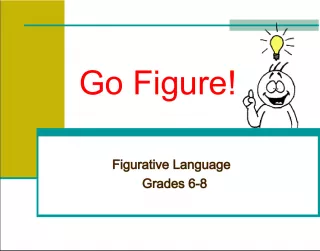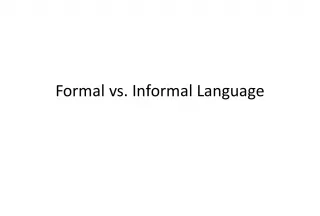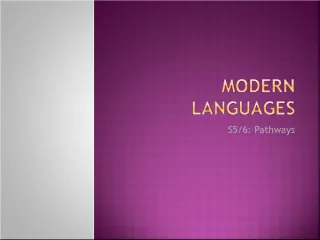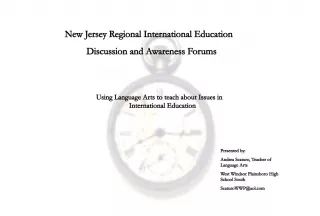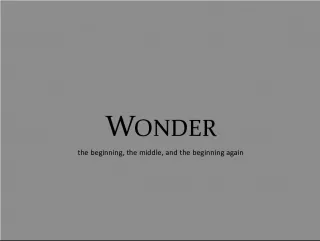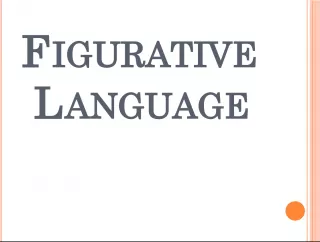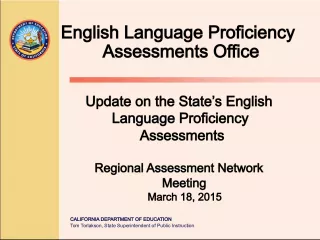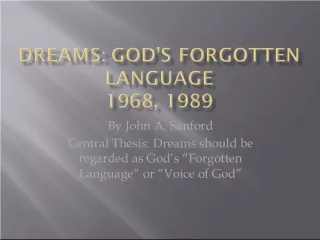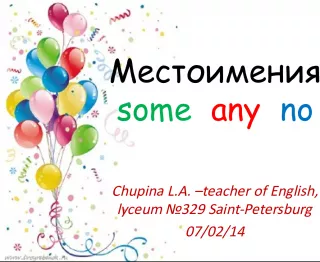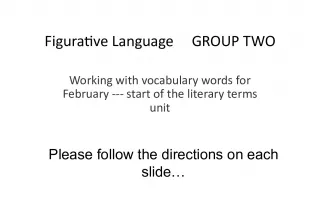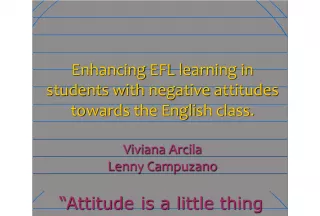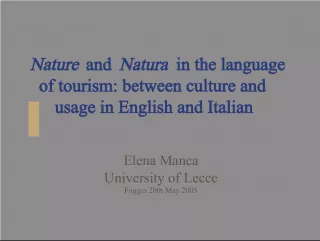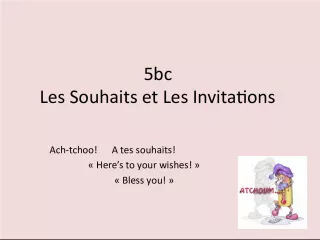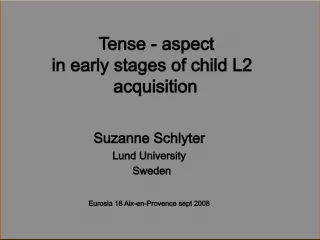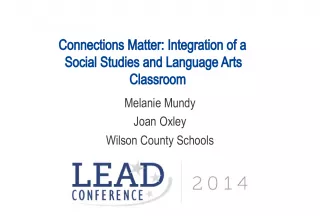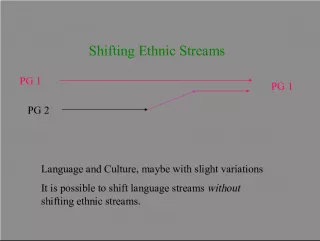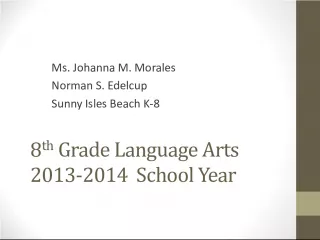The Multifaceted Use of Language


In this article, we explore the various ways in which language is utilized in different contexts. Language serves as a means of expressing emotions, drowning out uncomfortable silence, and establishing a sense of
- Uploaded on | 3 Views
-
 borja
borja
About The Multifaceted Use of Language
PowerPoint presentation about 'The Multifaceted Use of Language'. This presentation describes the topic on In this article, we explore the various ways in which language is utilized in different contexts. Language serves as a means of expressing emotions, drowning out uncomfortable silence, and establishing a sense of. The key topics included in this slideshow are . Download this presentation absolutely free.
Presentation Transcript
Slide1Language and TOK
Slide2What do we use language for? To express emotion To drown out silence To establish a sense of belonging To establish relationships To enjoy the sound of language To affect other people’s emotions To affect other people’s behavior To convey information To lie or deceive
Slide3Hallo A simple "Hallo" can transmit a lot of things. The voice's tone shows if the speaker is happy, pleased, bored, hurried, angry, sad, scared, aggressive or dominant and the intensity of these states; irony, affection, support or joke.
Slide4A Wonder To produce a phrase, about 100 muscles of the chest, neck, jaw, tongue and lips must collaborate.
Slide6Speech (born or acquired?)
Slide7The human speech and learning the speech requires early interaction with others. The brain seems to have a period when it acquires speech and if this period is skipped over, the individual won't gain later the speech skill. Human speech can develop only inside a community and at the age when the brain is growing.
Slide9The World’s Languages It’s estimated that up to 7,000 different languages are spoken around the world. 90% of these languages are used by less than 100,000 people.
Slide102,200 of the world’s languages can be found in Asia, while Europe has a mere 260.
Slide11The world's most widely spoken languages by number of native speakers and as a second language, according to figures from UNESCO (The United Nations’ Educational, Scientific and Cultural Organization), are: 1. Mandarin 2. Chinese (Non-Mandarin) 3. English 4. Spanish 5. Hindi (India) 6. Arabic, 7. Bengali (Bangladesh) 8. Russian 9. Portuguese (Brazil) 10. Japanese 11. German 12. French.
Slide13Body Language Body language is a form of mental and physical ability of human non-verbal communication, consisting of body posture, gestures, facial expressions, and eye movements. James Borg argues that human communication consists of 93 percent body language and paralinguistic cues, while only 7% of communication consists of words themselves
Slide16DO N W Can we think without language?
Slide17Quotes….. “I know more than I can say” Michael Polanyi “If you can’t say it you can’t know it” Hans Reichenbach
Slide18Linguistic Determinism The languages we use determine what we can think (and perceive.) The Sapir-Whorf Hypothesis suggests that our thoughts are completely limited by our language.
Slide19Linguistic Determinism According to linguist Steven Pinker, Inuit cultures use 12 distinct words for snow.
Slide20Linguistic Determinism Languages like Spanish, French, German and Russian oblige you to assign a male or female gender to a whole range of objects. Languages that treat an inanimate object as a he or a she force their speakers to talk about such an object as if it were a man or a woman.
Slide21Linguistic Determinism In the 1990s, for example, psychologists compared associations between speakers of German and Spanish. There are many inanimate nouns whose genders in the two languages are reversed. A German bridge is feminine (die Brücke), for instance, but it is masculine in Spanish (el puente); and the same goes for clocks, apartments, forks, newspapers, pockets, shoulders, stamps, tickets, violins, the sun, the world and love.
Slide22Linguistic Determinism When speakers were asked to grade various objects on a range of characteristics, Spanish speakers deemed bridges, clocks and violins to have more “manly properties” like strength, but Germans tended to think of them as more slender or elegant.
Slide23Feminine (die Brücke)
Slide24 Masculine (el puente)
Slide25Linguistic Realism(Counter-claim to Linguistic Determinism) Linguistic realism: Our mental world is far richer than our vocabulary. Can you think of any feelings or thoughts for which there aren’t any words in your language? Example: “I can’t describe how I feel with words…”
Slide26Unnamed thoughts SCONSER (n) A person who looks around when talking to you, to see if there's anyone more interesting. SHOEBURYNESS (n) The vague uncomfortable feeling you get when sitting on a seat which is still warm from somebody else.
Slide27Unnamed thoughts Again, all these “words” are probably naming things with which you are already familiar, but which are unnamed. (Hence, our mental worlds are far richer than our vocabulary.)
Slide29Do N W Do we use language do display group identity? Can you give examples.
Slide30Language as markers of socialgroups Because patterns for language use are shared by members of a specific group, communicative style becomes a way of displaying group identity. Linguistic differences may become noticeable markers of social groups. For example, speaking a language with a particular accent may imply membership of an ethnic minority or social class or one's area of origin (Appalachian English, Ebonics, Spanglish etc.)
Slide31In America, which is an individualistic culture, we use a personal style of communication. Two of the most frequently used words in our culture are “I” and “you”. Linguists point out that it is impossible for Americans to hold a conversation without using these pronouns. Compared to other cultures, American culture is not very formal, so it is appropriate to say “you” to your boss, to the President, to a stranger, to your spouse or to your child. However, in Thai language there are 12 forms of the pronoun “you”, which depend of factors such as status or level of intimacy.
Slide33Language & History Clans of long ago that wanted to get rid of their unwanted people without killing them used to burn their houses down - hence the expression "to get fired.“ "Goodbye" came from "God bye" which came from "God be with you.“ Shakespeare's works contain first-ever recordings of 2,035 English words. He invented thousands of words including critical, frugal, excellent, barefaced, assassination, gloomy, and countless.
Slide35Language & Sense Perception Aoccdrnig to a rscheearch procejt at Cmabrigde Uinervtisy, it deosnt mttaer waht oredr the ltteers in a wrod are, the olny iprmoatnt tihng is taht the frist and lsat ltteer be in the rghit pclae. Tihs is bcuseae the huamn mnid deos not raed ervey lteter
Slide37Psychological meaning of words
Slide38Got a flat Tire? Its pouring with rain and you are changing a flat tire when you hear a stranger say: “ Got a flat Tire?” What is the psychological meaning here?
Slide39Hello. I can see that you have a flat tire and that you are changing it. It is not good weather to be doing a job like that - I wouldn't want to be doing it by myself! And so perhaps, even though I do not know you, I can help. But I don't really know you well enough just to offer - and I do not wish to be embarrassed by a rejection. Are you approachable and friendly? This is my voice - you can see I am trustworthy. How about you? Will you give me a sign as to whether or not you wish for help?

